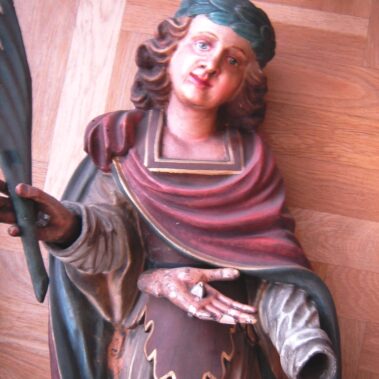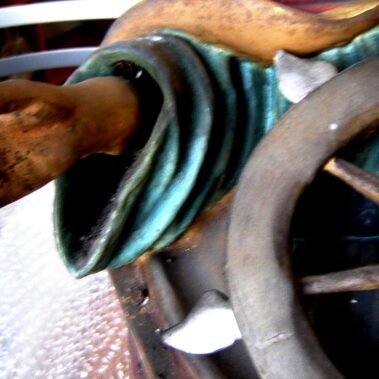Church of St James the Greater in Jihlava, Czech Republic

| Address: | Jakubské náměstí, 586 01, Jihlava |
|---|---|
| Description of work: | Restoration of individual parts of the altars
Complete restoration of four oil paintings from the altars of St Ursula and The Virgin Mary Installation of scaffolding |
| Investor: | The Royal Canonry of the Premonstrate Order, Strahov, Prague |
| Contractor: | GEMA ART GROUP a.s. |
| Implementation: | 11/2007 – 03/2009 |
Silver ore was discovered in the region of Czech-Moravian Uplands as early as the 1340s. Soon afterwards the Royal mining town of Jihlava (German Iglau) was founded. At the same time as the first burgher townhouses were built, the foundations of the Church of St James were also laid. The new church was ceremonially consecrated by the Bishop of Olomouc, Bruno of Schaumburk, on May 31st 1257 but only the presbytery was then built. The completed church was a three-nave structure with two imposing towers at its front. The administration of the new church was entrusted to the Premonstratensian monastery in nearby Želivy. When the Jihlava convent of the Želivy monastery ceased to exist in 1567, the church came under the jurisdiction of the Premonstratensian monastery in Strahov, Prague.
The south tower of the church was first altered in the 1650s, when it had to be lowered due to its unstable condition. The destabilization was caused by a fire, which engulfed the whole town in 1523. The reconstructed tower was then given a new bell named “Zuzana”, the second largest bell in all Moravia after the bell of the Cathedral of St Wenceslas in the town of Olomouc.
The Gothic appearance of the church was somewhat affected by the addition of the Baroque Chapel of The Virgin Mary of Seven Sorrows, with its richly ornamented interior, in the years 1702 and 1703. Most of the church contents also originate from the 18th century.
The most recent building alternations in the spirit of Historic (Romantic) Purism took place between the years 1904 and 1906 under the leadership of the architect Richard Völkel. A new roof was installed at the same time. Further work took place within the interior during the 1980s.
Restoration work involved the renovation of three altars of the Church of St James in Jihlava: the altar of St Anna, the altar of St Ursula and the altar of The Virgin Mary, and included all of the altars’ architecture as well as individual sculptural groups. Four oil paintings of the altars of St Ursula and The Virgin Mary were also restored.
Prior to restoration a survey of surface colour layouts was carried out. The restoration work was divided into two phases: the altars of St Ursula and The Virgin Mary were restored between November 2007 and November 2008, the altar of St Anna from September 2008 until March 2009.
Restoration of the altar architecture, sculptures and painting on the altars of St Anna, St Ursula and The Virgin Mary:
The altar of St Anna is richly decorated with statues of the “Fourteen Helpers in Need”, which surround the larger central statue of St Anna with the Virgin Mary. The Fourteen Helpers in Need are St Barbara, St Margaret, St George, St Catherine, St Giles, St Denis, St Eustace, St Giovanni, St Pantaleon, St Erasmus, St Agnes, St Christopher and St Cyriac.
The altar of The Virgin Mary is ornamented with a statue of The Virgin Mary holding Baby Jesus, surrounded by angels.
The altar of St Ursula is dominated by a portrait of the saint and bears no other sculptural ornamentation.
It was established during research that the altars originate from the Late Baroque era and were made from lime and pine wood. The timber was severely affected by woodworm and parts of it deteriorated to such a degree that they became detached. In the lower parts, where the level of dampness was highest, the timber was damaged by rot. The surface of the altars was covered in dirt deposits deep enough to penetrate into the individual layers of colour.
All elements of the altar architecture were first carefully dismantled and moved to a specialist workshop. The layers of dirt were removed and in-depth petrifaction of the timber carried out. Due to the high degree of deterioration, the timber was first submerged and then gradually coated in petrifying solution. Corroded nails and wall-hooks were removed to prevent further damage to the wood.
Preserved parts of gilding and colour polychrome were fixed and reattached to the wood. Visually unpleasant blackened bronzing was removed from the surfaces.
Missing pieces of timber were replaced by copies and cracks in-filled. Where required re-gilding with gold leaf was carried out. To conclude the wood was conserved using wax emulsion and the altars were reassembled in the church.
Pro návštěvníky je zpřístupněna severní věž kostela sv. Jakuba.
Otevírací doba:
duben, květen, září: 10:00 – 13:00, 14:00 – 18:00 (sobota, neděle)
červen – srpen: 10:00 – 13:00, 14:00 – 18:00 (denně kromě pondělí)
Vstupné:
Dospělí: 20 Kč
Děti a senioři: 10 Kč





































